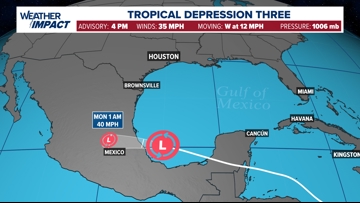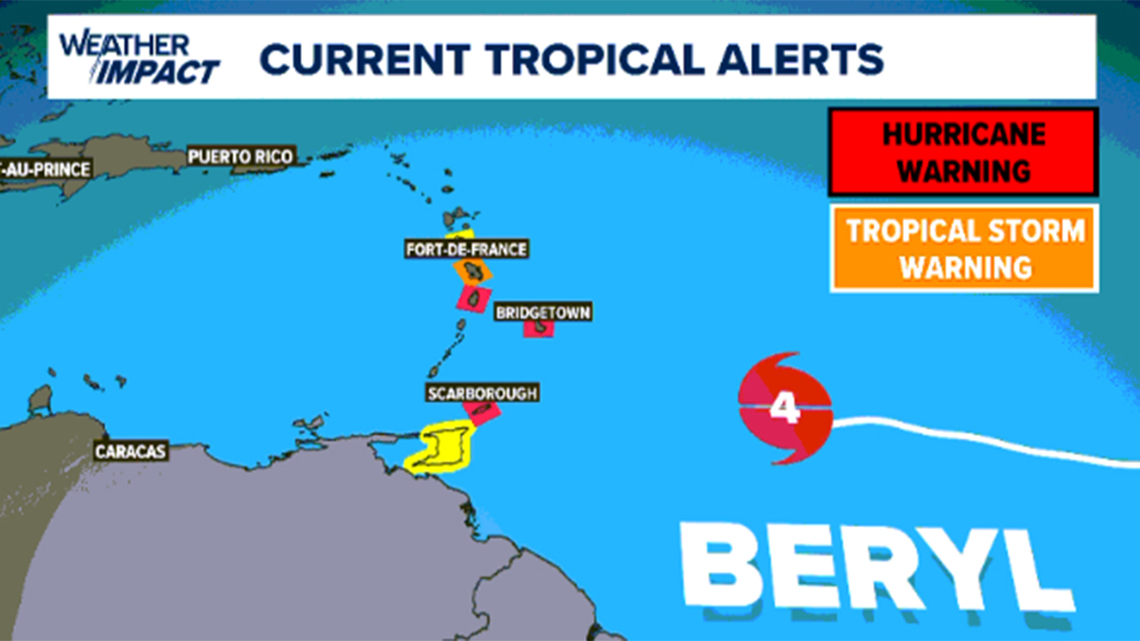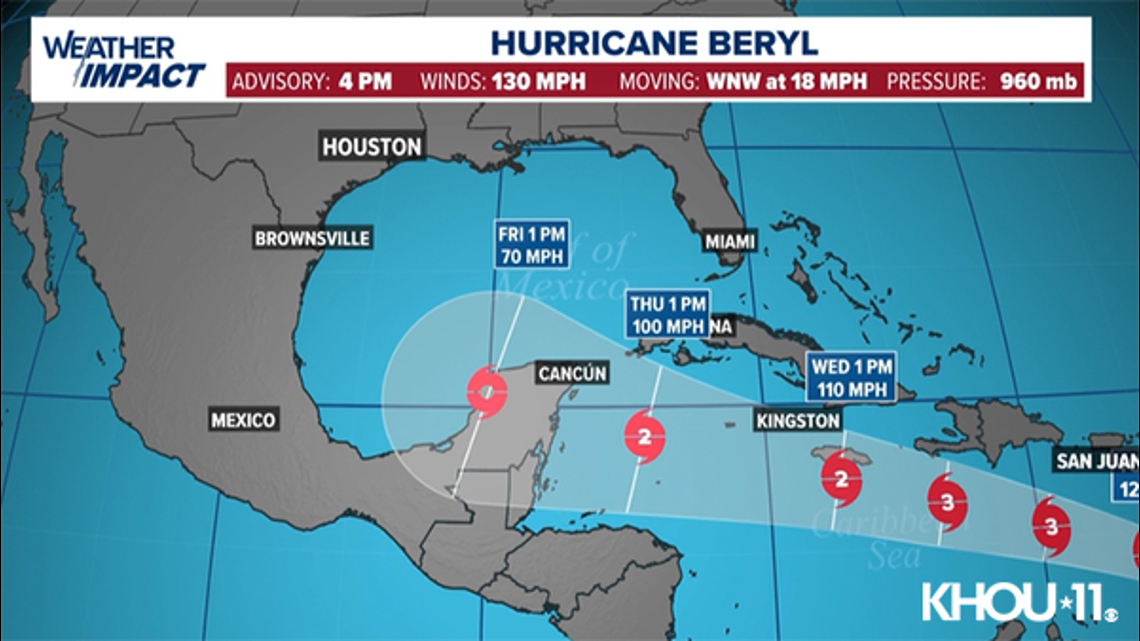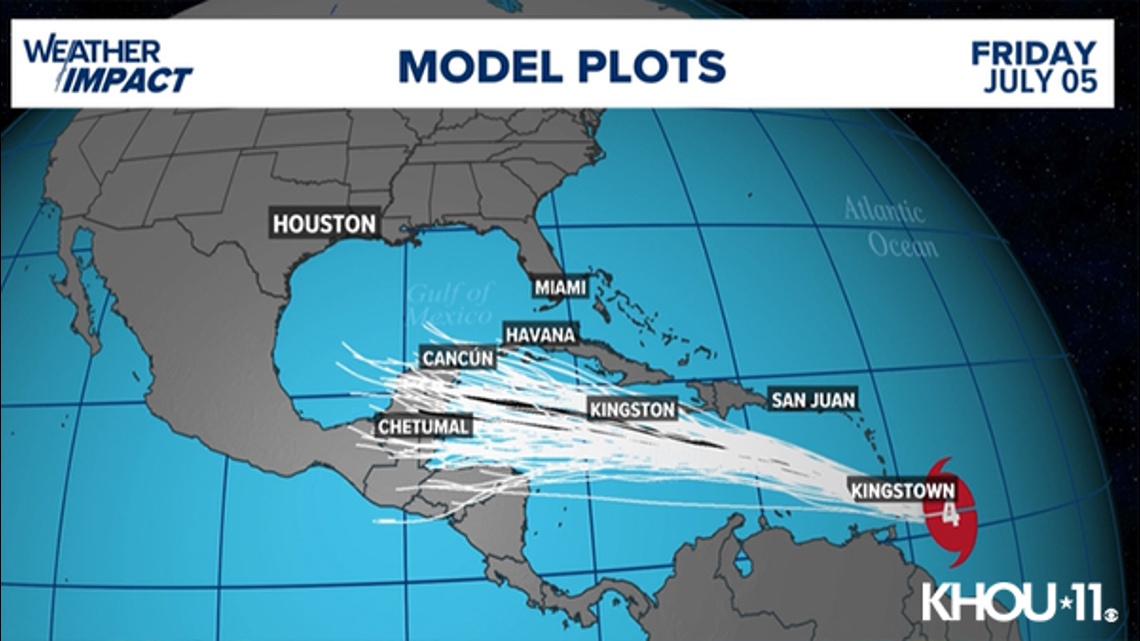- Another $500M for Hurricane Helene relief in North Carolina passes key hurdle
- Crews battle wildfire in McDowell County, NC
- Wildfire in McDowell County, NC is 20% contained, officials say
- California governor asks Congress for nearly $40 billion for Los Angeles wildfire relief
- North Buncombe High School students lead recovery efforts for NC farmers post-Hurricane Helene
Hurricane Beryl remains a Cat. 4 storm as it heads west-northwest | TD 3 forms in SW Gulf

At 4 p.m., Beryl had maximum sustained winds at 130 miles per hour. It’s not moving to the west-northwest at 18 mph.
HOUSTON — Hurricane Beryl strengthened into what experts called an “extremely dangerous” Category 4 storm as it approached the southeast Caribbean, which began shutting down Sunday amid urgent pleas from government officials for people to take shelter.
The storm was expected to make landfall in the Windward Islands on Monday morning. Hurricane warnings were in effect for Barbados, St. Lucia, Grenada, Tobago and St. Vincent and the Grenadines.
CURRENT LOCATION/PATH: With an update at 7 p.m. Sunday, Beryl was a Category 4 storm with maximum sustained winds of 130 mph, moving west-northwest at 18 mph. (Update in Spanish).
This is the earliest in a calendar year that there’s been a Cat. 4 storm in the Atlantic basin. The previous earliest was July 8, which happened in 2005.
“This is a very dangerous situation,” warned the National Hurricane Center in Miami, which said that Beryl was “forecast to bring life-threatening winds and storm surge.”
Beryl was located about 250 miles (400 kilometers) southeast of Barbados. It had maximum sustained winds of 130 mph (215 kph) and was moving west-northwest at 18 mph (30 kph). It is a compact storm, with hurricane-force winds extending 35 miles (340 kilometers) from its center.
A tropical storm warning was in effect for Martinique. A tropical storm watch was issued for Dominica, Trinidad, Haiti’s entire southern coast, and from Punta Palenque in the Dominican Republic west to the border with Haiti.
Beryl is expected to pass just south of Barbados early Monday and then head into the Caribbean Sea as a major hurricane on a path toward Jamaica. It is expected to weaken by midweek, but still remain a hurricane as it heads toward Mexico.
Tropical Depression 3 forms
The third tropical depression of the Atlantic hurricane season formed in the Bay of Campeche. It’s expected to move into Mexico. It’s expected to bring flooding and possible landslides.

Watches and warnings in effect
Hurricane warnings in effect for Barbados, St. Lucia, Grenada, and St. Vincent and the Grenadines.


Beryl path


Beryl spaghetti models


Potential threats
Beryl is expected to be a major hurricane when it reaches the Windward Islands early Monday. It’s expected to bring destructive hurricane-force winds and life-threatening storm surge. Heavy rainfall and localized flooding along the Windward Islands is expected late Sunday and Monday.
Track the storm
Hurricane Season links
Hurricane season 2024 forecast
Colorado State University released its forecast update for the 2024 hurricane season, maintaining that it will be a busy one. In April, they predicted that we could see 23 named storms and 11 hurricanes with five becoming major hurricanes. They blame the extremely warm tropical Atlantic and likely “La Niña” as the primary reasons.
RELATED: Colorado State University releases hurricane season forecast update, maintains it will be a busy one
On average, the Atlantic sees about 14 named storms each hurricane season. Of those, seven become hurricanes with three becoming major (Category 3 or above) storms.
Why such an active season? Dr. Phil Klotzbach, lead forecaster at CSU, says it’s because of two main factors — above-normal sea surface temperatures and expected La Niña conditions this summer. The warm water adds more energy to the tropics, making fuel for these storms more available. But perhaps more importantly, La Niña usually reduces vertical wind shear.
Winds blowing across a developing or mature tropical system can keep a budding system from developing and weaken stronger storms. This reduces the total storm count. But when La Niña conditions are in place, this wind shear is often reduced. That, combined with the warm ocean surface temps is why Dr. Klotzbach believes more storms than normal will form.